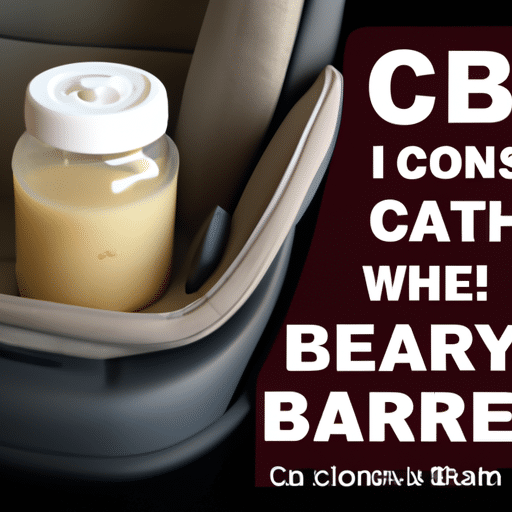Imagine a world where feeding your baby in a car seat is not only possible, but safe and convenient. With the innovative product “Can Babies Eat in a Car Seat?”, this dream becomes a reality. This revolutionary device ensures that your little one can enjoy a meal while comfortably seated in their car seat, making meal times on-the-go a breeze. Say goodbye to messy spills and fussy feedings, and say hello to stress-free dining experiences for both you and your baby.
Safety concerns
When it comes to feeding your baby in a car seat, there are some important safety concerns to keep in mind. These safety concerns include the risk of choking, airway obstruction, aspiration, and spills and messes. It’s crucial to be aware of these risks in order to ensure your baby’s safety and well-being during feeding times in the car.
Risk of choking
Choking is a serious concern for babies, as their airways are small and easily obstructed. When feeding your baby in a car seat, there is an increased risk of choking due to the semi-reclined position. This position can make it more difficult for your baby to swallow properly and can increase the likelihood of food or liquid entering the airway.
Risk of airway obstruction
In addition to the risk of choking, the semi-reclined position in a car seat can also pose a risk of airway obstruction. If your baby’s head falls forward or to the side while eating, it can potentially block the airway and make it difficult for them to breathe. It’s important to ensure that your baby’s head is properly supported and that they are sitting in a secure and comfortable position while feeding.
Risk of aspiration
Aspiration occurs when food or liquid enters the airway instead of going down the esophagus and into the stomach. Feeding your baby in a car seat can increase the risk of aspiration due to the potential for improper swallowing and positioning. If your baby aspirates, it can lead to choking, coughing, and potentially more serious respiratory issues. Ensuring safe feeding practices and monitoring your baby closely can help reduce the risk of aspiration.
Risk of spills and messes
Feeding a baby can be messy at the best of times, and doing so in a moving vehicle can make it even more challenging. The risk of spills and messes is a concern when feeding your baby in a car seat, as it can be distracting and potentially create a hazardous environment. It’s important to take precautions to minimize spills and messes and to create a safe and clean feeding space for your baby.
Car seat regulations
Before deciding whether or not to feed your baby in a car seat, it’s important to familiarize yourself with car seat regulations. These regulations include guidelines from car seat manufacturers, recommendations from pediatricians, and legal requirements.
Guidelines from car seat manufacturers
Car seat manufacturers provide guidelines regarding the proper use of their products, including any restrictions or recommendations for feeding your baby in a car seat. It’s essential to follow these guidelines to ensure the safety and effectiveness of the car seat.
Recommendations from pediatricians
Pediatricians are experts in the field of baby care and can provide valuable recommendations when it comes to feeding your baby in a car seat. They can offer advice on safe feeding practices, proper positioning, and any potential risks to be aware of. Consulting with your pediatrician can help you make an informed decision about whether or not feeding your baby in a car seat is the right choice for you and your little one.
Legal requirements
In some jurisdictions, there may be specific legal requirements regarding feeding your baby in a car seat. It’s important to research and understand the laws in your area to ensure that you are in compliance and not putting your baby at risk. Ignoring these legal requirements can have serious consequences and may compromise the safety of your baby.
Feeding options
When it comes to feeding your baby in a car seat, there are a few different options to consider. These options include breastfeeding, bottle feeding, and introducing solids. Each option has its own considerations and potential benefits, depending on your baby’s age and individual needs.
Breastfeeding
Breastfeeding is a natural and convenient way to nourish your baby. It provides essential nutrients and antibodies that can help protect your baby’s health. When breastfeeding in a car seat, it’s important to consider safety concerns, comfort, and positioning.
Bottle feeding
Bottle feeding can offer convenience and flexibility, allowing others to help with feeding and giving you more control over the amount your baby consumes. When bottle feeding in a car seat, it’s crucial to choose the right bottle and nipple and to ensure that your baby is in a safe and comfortable position.
Solid foods
As your baby grows and develops, introducing solid foods becomes an important part of their nutritional needs. Feeding solids in a car seat can present some unique challenges, but with the right safety precautions and appropriate food choices, it can be done safely and effectively.
Breastfeeding in a car seat
Breastfeeding in a car seat can be a convenient option for many parents, especially when on the go. However, it is important to address safety concerns and ensure proper comfort and positioning for both you and your baby.
Safety concerns
When breastfeeding in a car seat, it’s crucial to be aware of the risk of choking, airway obstruction, and aspiration. The semi-reclined position and potential for improper swallowing can increase these risks. It’s important to closely monitor your baby’s feeding and ensure that they are in a secure and well-supported position.
Comfort and positioning
To ensure a comfortable breastfeeding experience in a car seat, it’s important to find a position that works for both you and your baby. Some mothers find that using a nursing pillow or rolled-up blanket can provide additional support and help maintain proper positioning. Experimenting with different positions and finding what works best for you and your baby can help ensure a comfortable and successful breastfeeding session in the car seat.
Tips for breastfeeding in a car seat
Here are a few tips to make breastfeeding in a car seat more manageable:
- Choose a well-fitted car seat that provides adequate support for your baby’s head and neck.
- Plan your feeding sessions strategically, ensuring that your baby is not too hungry or too full.
- Take regular breaks during longer car trips to allow your baby to feed in a more comfortable environment.
- Keep a burp cloth or washcloth handy to quickly address any spills or messes that may occur during feeding.
- Practice breastfeeding in a car seat at home before attempting it on the road to familiarize yourself with the process and address any concerns.
Remember, always prioritize safety and comfort while breastfeeding your baby in a car seat.

Bottle feeding in a car seat
If you have chosen to bottle feed your baby, it’s important to address safety concerns and choose the right bottle and nipple for feeding in a car seat.
Safety concerns
Similar to breastfeeding, bottle feeding in a car seat can pose risks of choking, airway obstruction, and aspiration. It’s important to ensure that your baby is in a secure position and closely monitored during feeding to minimize these risks.
Choosing the right bottle and nipple
When it comes to bottle feeding in a car seat, selecting the right bottle and nipple can make a significant difference. Opting for a bottle with a slow flow nipple can help reduce the risk of choking and ensure that your baby is not overwhelmed by the flow of milk or formula.
Tips for bottle feeding in a car seat
Here are a few tips to make bottle feeding in a car seat safer and more convenient:
- Ensure that the bottle is securely held in place and easily accessible while driving.
- Monitor your baby closely to ensure that they are feeding safely and not experiencing any difficulties.
- Avoid feeding your baby while the car is in motion, if possible. It’s safer to pull over and attend to your baby’s feeding needs.
- Consider using a bottle holder or a hands-free system that allows you to securely hold the bottle while keeping your hands on the wheel.
Remember, safety should always come first when bottle feeding your baby in a car seat.
Introducing solids in a car seat
Introducing solid foods to your baby’s diet is an exciting milestone. However, feeding solids in a car seat can present additional safety concerns and considerations.
Safety concerns
When feeding your baby solids in a car seat, it’s important to be mindful of choking hazards associated with certain foods. Avoid giving hard, small, or round foods that can pose a choking risk. Additionally, be aware of the potential for spills or messes that can create a hazardous environment.
Appropriate age for introducing solids
The American Academy of Pediatrics recommends introducing solids around 6 months of age. It’s important to ensure that your baby is developmentally ready and showing signs of readiness for solid foods before attempting to feed them in a car seat.
Choosing appropriate solid foods
When introducing solids in a car seat, it’s important to choose appropriate foods that are easy to handle and pose little to no choking risk. Soft fruits, steamed vegetables, and well-cooked grains are good options. It’s best to avoid foods that can easily break off into small pieces or become a choking hazard.
Tips for feeding solids in a car seat
Here are a few tips to help you safely introduce solids in a car seat:
- Always supervise your baby closely during feeding to reduce the risk of choking.
- Start with small, soft pieces of food that are easy for your baby to chew and swallow.
- Use utensils that are appropriate for your baby’s age and development to make feeding easier and safer.
- Bring along a bib and wipes to clean up any spills or messes that may occur during feeding.
Remember, safety and appropriate food choices are key when introducing solids in a car seat.
Alternative feeding positions
While feeding your baby in a car seat may not always be the most ideal option, there are alternative feeding positions and strategies that can be considered to ensure your baby’s comfort and safety.
Pulling over to feed
If possible, consider pulling over to a safe location to feed your baby. This allows for a more relaxed and comfortable feeding experience, reduces distractions while driving, and minimizes the risk of spills and messes in the car seat.
Using a travel high chair
Investing in a portable travel high chair can provide a safer and more comfortable feeding space for your baby. These high chairs can be easily attached to a stable surface, such as the backseat of a car or a picnic table, providing a secure and supportive environment for feeding.
Creating a safe feeding space
If pulling over or using a travel high chair is not an option, you can create a safe feeding space within the car. Place a stable surface, such as a tray or table, in the backseat and ensure that it is securely attached. This can help minimize the risk of spills and allow for a more comfortable feeding experience for your baby.
Minimizing distractions while feeding
Feeding your baby in a car seat can be challenging, especially when trying to focus on the road and ensure a calm environment. Here are some tips to help minimize distractions and ensure a safer feeding experience:
Focusing on the road
Always prioritize your focus on the road while driving. Avoid turning your attention to your baby or feeding-related tasks while the vehicle is in motion. If your baby needs attention, consider pulling over to safely attend to their needs.
Avoiding multitasking
While it may be tempting to multitask, avoid engaging in other activities, such as eating or using electronic devices, while feeding your baby in a car seat. These distractions can compromise your ability to monitor your baby and increase the risk of accidents.
Ensuring a calm environment
Creating a calm and quiet environment within the car can help promote a safer feeding experience. Minimize loud noises, such as music or conversations, that can distract your attention from your baby and potentially startle them.

Practical considerations
Feeding your baby in a car seat can present some practical considerations that need to be addressed to ensure a smooth and safe experience.
Feeding during long car trips
If you’re planning a long car trip, it’s important to consider the logistics of feeding your baby. Plan breaks in your journey to allow for rest and feeding. Ensure that you have enough supplies, such as bottles or breast milk, to meet your baby’s feeding needs throughout the trip.
Managing spills and messes
Feeding in a car seat can be messy, and it’s important to be prepared to manage spills and messes. Keep wipes, burp cloths, or a small towel within reach to quickly and effectively clean up any spills. Having a change of clothes for your baby can also be helpful in case of any major messes.
Considering the baby’s temperament
Every baby is unique, and it’s important to consider your baby’s temperament when deciding to feed them in a car seat. Some babies may be more comfortable and content in a car seat, while others may find it uncomfortable or distressing. Pay close attention to your baby’s cues and adjust your feeding approach accordingly.
Conclusion
Feeding your baby in a car seat can be a convenient option for busy parents on the go. However, it’s crucial to be aware of the safety concerns associated with this practice and take appropriate measures to minimize risks. Whether you choose to breastfeed, bottle feed, or introduce solids in a car seat, prioritizing safety, comfort, and a calm environment should be your top priorities. Consider alternative feeding positions and strategies if feeding in a car seat proves to be challenging. Always consult with your pediatrician for personalized advice and recommendations to ensure the well-being of your baby during feeding times in the car.








